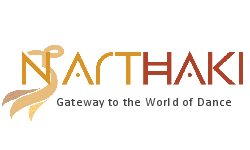
|   |

|   |
Khongkhul Liba - In the Footsteps of a Legacy - Tapati Chowdhurie e-mail: tapatichow@yahoo.co.in Photos: Sujoy Kundu May 16, 2025 Khongkhul Liba: In the Footsteps of a Legacy - Manipuri Dance... such a book was long awaited, and once again Manipuri dance exponent Priti Patel has been the first to use her culinary gift with finesse to serve on a platter a dish made with a judicious mix of all the ingredients that Manipuri dance is to both the layman and connoisseurs. She has sincerely walked in the footsteps of a legacy and in the process, has inspired many to join this journey. The book was launched in Hall 2 of the Indian Museum at Chowringhee in Kolkata on 7th May, when citizens were in the grip of fear of an impending war with one of India's neighbours, escalated with the announcement of a mock drill that very day. All withstanding braving fears, Priti's call had to be answered, and most importantly, it was a full hall. 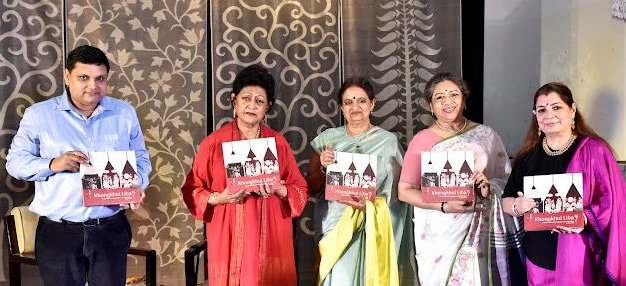 Book release In conversation with Oindrila Dutt, a longtime friend of the author, Priti Patel gave us an insight into the contents of the book, which aroused the interest of the audience to immediately go through the book. (Yours truly found the book totally absorbing and could not leave it till she had read it from cover to cover). The book is a store house of A to Z of all that Manipuri dance is. "The dance of Manipur cannot be learnt or appreciated without delving into the region's rich history and vibrant living culture. In Manipur, dance is intricately woven into the daily life, rituals, festivals, and even the milestones of birth and death. Nothing happens without dance", aptly states Prof. Anuradha Lohia in the preface of the book. Starting with the history of Manipuri dance and its evolution, the book has chapters on Thang-Ta, Lai Haroaba, Sankirtana, Pung Cholom, the Cosmic Dance of Radha Krishna, and dances for festivities, along with chapters on the Masters or Ojhas, ending with dances for children. A whole chapter is on inspirations taken from nature. The book has dealt with a chapter on modern influences. Often, mere words accompanied with pictures are insufficient to facilitate a full understanding of dance movements. Very significantly, some pages have been provided with QR codes, as one finds on page 87 describing Kang Chingba / The Ratha Yatra, which may be scanned to see exact movements. Just as Priti Patel has walked in the footsteps of legacy, there will be young dancers who will walk in the footsteps of the legacy that the Gurus of Manipur have handed down. So, she had the young perform a traditional repertoire soon after the book release. Priti has created the Anjika Foundation, which supports these young dancers and facilitates their training. 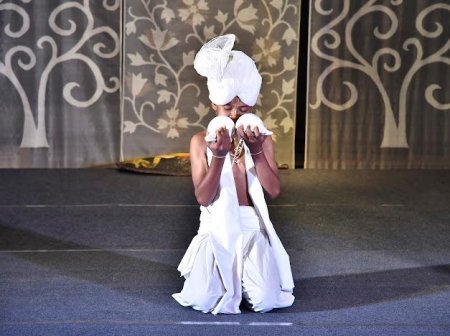 Blowing double conch 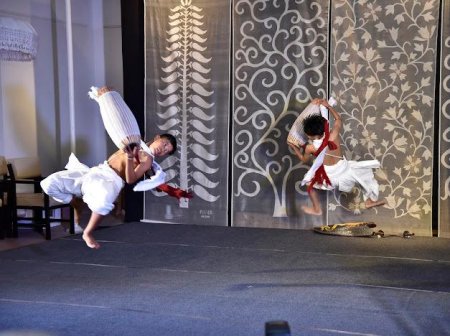 Pung cholom True to style and tradition, a young boy flagged off the recital playing the Moibung/double conch shell. He is in the process of learning this special kind of blowing the Moibung, which is to be found nowhere in the subcontinent. Two young boy dancers performed Pung Cholom, a stylized classical dance form, with a specific system of grammar, starting with posture, basic steps and polished movements with intricate rhythmic patterns - a precursor of Sankirtana. They created magic on stage as they went round in circles with a unique kind of jump and de-turbaned themselves with a tilt of their heads. And the audience appreciated it. With Prabandha Nartan, Wangkheirakpam Gunchenbi Devi, in the typical attire of child Krishna and Wangkheirakpam Henthoi Devi in the role of Radha, performed a technical piece from the Rasleela displaying the lasya and tandava technique of Manipuri classical dance, emphasizing a pure, abstract, and rhythmic dance sequence, and focusing on the beauty of movement, to a musical composition. They were marvellous. The youngsters have joined the journey of carrying on the tradition, soon to become the Masters themselves, and the legacy is carried forward. 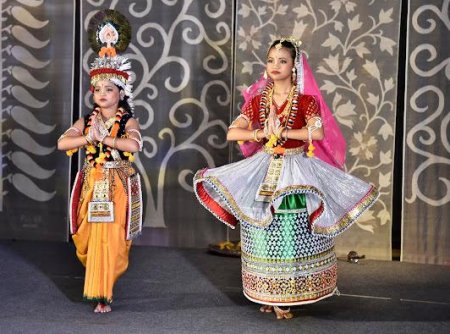 Radha-Krishna 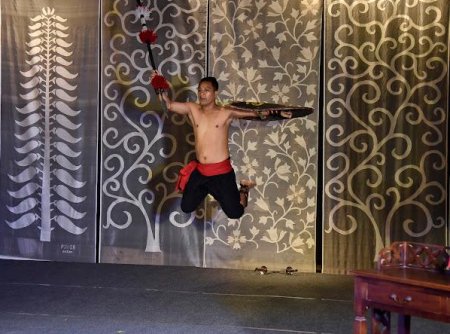 Thang Ta The audience had a brief glimpse of Thang Ta - the art of the shield and sword, which has a hoary past and falls under the category of martial arts. Anyone who sees Thang Ta for the first time is on pins and needles, in fear of the performers hurting themselves. Legend has it that King Bhagyachandra performed the ritual spear dance at the Khebu Ching peak in 1765, during his exile, and managed to save Manipur from a Burmese invasion. The Ta Khousaba dance with the spear and the Thang Leiteng dance with the sword were, of course, performed by a senior male dancer. Dhol Dholak Cholom, performed during the festival of Holi, was the grand finale of the evening. It was a spectacular performance as the two young lads beat intricate rhythms on their drums and went round the dance area producing intricate rhythms at different speeds. They enthralled the dance lovers.  Tapati Chowdhurie trained under Guru Gopinath in Madras and was briefly with International Centre for Kathakali in New Delhi. Presently, she is a freelance writer on the performing arts. She is the author of 'Guru Gopinath: The Making of a Legend.' |